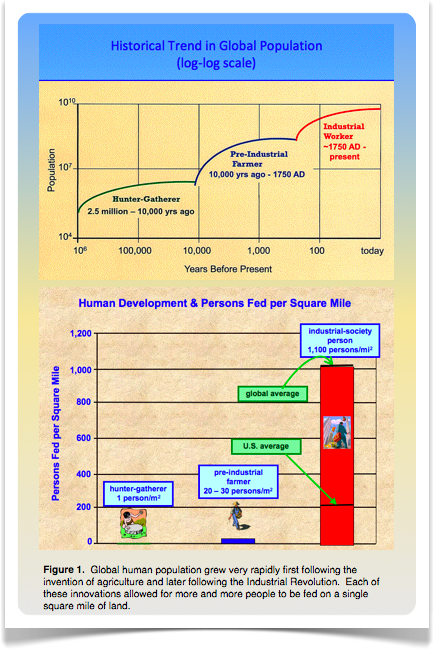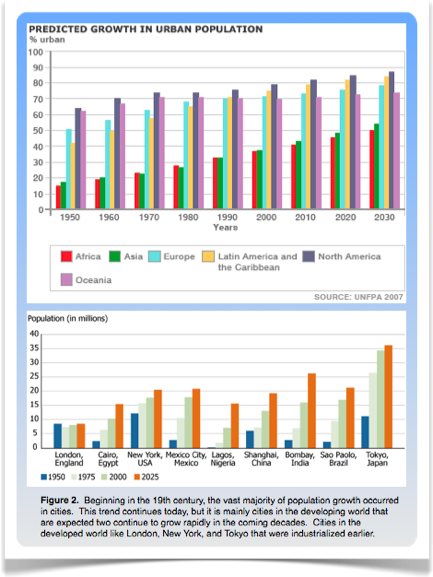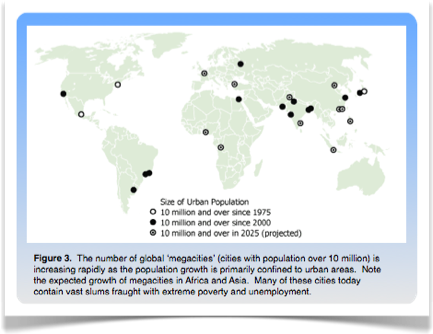

Concerns of a Future World
Just like their prehistoric ancestors, modern humans face the constant challenge of extracting enough resources from the accessible environment to simultaneously support multiple generations of human life. Until around 10,000 years ago, there were never more than a few million people living on Earth at once (Ponting, 1993). For the next 9,700 years or so, the global human population grew to around 500 million. Just as it began to stabilize at this new level, the Industrial Revolution allowed for another massive expansion of human population to its present day level nearing 7 billion (United Nations Department of Economic and Social Affairs/Population Division, 2009). In order to do so, humans have devised numerous technologies that can access previously unused energy resources such that much larger crop yields can be attained from each square mile of fertile land (Gates, 2009) (see Figure 1).
The significant question, though, is for how long? That is, have humans surpassed the carrying capacity of their planet in the long term? Since most of the technological breakthroughs of the Industrial Revolution depend upon nonrenewable energy and these resources are running out, the short answer is yes (Adas, 1990). On the other hand, Homo sapiens has adapted and survived in numerous harsh environments, and who is to say that it cannot adapt to the predicted changes in the global environment? Since the number of humans living on Earth is still rising, the need for large-scale changes in energy use is of critical importance in maintaining a reasonable quality of life for people in the future. By making educated guesses about what the world of the future will like look like, modern scientists can foresee potential threats and begin the long process of designing the technologies needed to sustain the future world.
Increased Urbanization. Research suggests that, among other things, future humans will be even more urbanized than their 21st century counterparts. In 1800, hardly 3 percent of the world’s population lived in cities (Grimond, 2007). In 1900, that figure had risen to 14 percent (Whitehouse, 2005). As shown in Figure 2, over 50 percent of contemporary humans live in urban environments, and research suggests that the vast majority of future world population growth will take root in urban areas, especially those in Asia and Africa (Grimond, 2007). Nevertheless, many cities in these countries are already among the most densely populated regions in the world. For instance, Mumbai, which already houses 18.2 million people, is expected to hold 26.4 million people in 2025 (Lewis, 2007). Similarly, Delhi is expected to grow from 15 million to 22.5 million. In the same time, the population of Shanghai is projected to grow from 14.5 million to 19.4 million. Even more astounding are the forecasts for Dhaka, Bangladesh and Karachi, Pakistan, both of which are expected to nearly double in population from around 11 million to 20 million in 2025.


Given the extremely high human population densities in large metropolises, the task of maintaining sanitary living conditions is extremely costly, but so too is failing to do so. There is evidence that the number of new infectious diseases has been on the rise of recent, likely as a result of the still rising population density around the world. Some researchers have described the megacities in the developing world as breeding grounds for new pathogens and mutant forms of old diseases (Jones et al., 2008; Tatem et al., 2008). This, along with the projected shortages of potable water, could interact to allow for the simultaneous infection of millions of people in a small area (Brown et al., 1999).
The growth of urban areas in the developing world has been increasingly associated with the formation of expansive slums fraught by crime, drug addiction, alcoholism, poverty, and unemployment (Davis, 2004). While many large cities in the developed world like New York and London are extremely prosperous, the emerging cities of tomorrow are among the most poverty-stricken regions in the world. For example, over 90% of the rapidly growing urban populations of Ethiopia, Malawi and Uganda already live in slums, and their governments do not have adequate resources to provide them the basic resources to maintain health (United Nations Population Fund, 2007). That being said, the need to feed the nearly 8 billion people expected to inhabit Earth in 2025 will be one of the most pressing concerns, especially as nations will be required to decrease usage of nonrenewable resources.


It is not just humans, however, who are vulnerable to elevating global population densities. Researchers modeling the effects of human population growth on global biodiversity generally agree that the expected population growth in the coming years has the potential to drastically reduce biodiversity on Earth (Luck, 2007), perhaps even triggering a second mass extinction of carnivorous megafauna (Cardillo et al., 2004). Between 2020 and 2050, McKee et al. (2003) predict that the number of endangered species will double. Since habitat destruction and pollution are anticipated to be among the largest causes of this trend, researchers can model future population distributions so as to minimize the detrimental effects of humans on the environment.
Urbanization and Conservation
Although the growth of cities has long gone hand in hand with pollution, habitat destruction, and other perils of the modern world, recent projections made by UN researchers shed a new light on the potential role of cities in the future of humanity. Given that we cannot act immediately halt population growth, research indicates that the further population of cities may be our saving grace in the years to come (Kariuki, 2007). By packing more people onto each square mile of already urbanized land, we could contain the ecologically destructive effects of humans, and in doing so, prevent further destruction of non-urbanized land and the ecosystems it supports. Humans are nowhere close to having all the technologies needed to sustain future megacities, but the world’s remaining biodiversity may hold the keys to a fully sustainable future. If this is the case, then cities just may be the road to adulthood that Homo sapiens have no choice but to take.
References
Adas, M. (1989). Machines as the Measure of Men : Science, Technology, and Ideologies of Western Dominance. Ithaca: Cornell University Press.
Brown, L.R., Gardner, G.T., B. Halweil (1999). Beyond Malthus: Nineteen dimensions of the population challenge. New York: W.W. Norton & Company.
Cardillo, M., Purvis, A., Sechrest, W., Gittleman, J.L., Bielby, J., & G.M. Mace (2004). Human Population Density and Extinction Risk in the World’s Carnivores, PLoS Biology 2(7), 909-914.
Daszak (2008). Global trends in emerging infectious diseases. Nature 451(21), doi:10.1038/nature06536.
Davis, M. (2006). Planet of Slums. London: Verso.
Dolan, E. (1971). TANSTAAFL, The Economic Strategy for Environmental Crisis. Madison, WI: Holt, Rinehart and Winston.
Gates, B. (2009). 2009 Annual Letter from Bill Gates: Agriculture. Retrieved, 12 April 2010, from Bill and Melinda Gates Foundation: http://www.gatesfoundation.org/annual-letter/Pages/2009-agricultural-development-africa-asia.aspx
Grimond, J. (2007). Survey: The world goes to town. The Economist 383(8527), 3.
Haub, C. (2002). How Many People Have Ever Lived on Earth?. Retrieved 12 April 2010, from Population Reference Bureau: http://www.prb.org/Articles/2002/HowManyPeopleHaveEverLivedonEarth.aspx
Jones, K.E., Patel, N.G., Levy, M.A., Storeygard, A., Balk, D., Gittleman, J.L., & P. Luck, G.W. (2007). A review of the relationships between human population density and biodiversity. Biol. Rev. 82, 607-645.
Kariuki, M. (2007). One in two ‘will live in cities’. Retrieved 12 April 2010, from BBC News: http://news.bbc.co.uk/2/hi/6244496.stm
Lewis M. (2007). Megacities of the Future. Retrieved 12 April 2010, from Forbes Magazine: http://www.forbes.com/2007/06/11/megacities-population-urbanization-biz-cx_21cities_ml_0611megacities.html
McKee, J.K., Sciulli, P.W., Fooce, C.D., & T.A. Waite (2003). Forecasting global biodiversity threats associated with human population growth. Biological Conservation 115, 161-164.
Ponting, C. (1993). A Green History of the World. New York: St. Martin’s Press.
Population Reference Bureau (2008). Human Population: Urbanization. Retrieved 12 April 2010, from Population Reference Bureau: http://www.prb.org/Educators/TeachersGuides/HumanPopulation/Urbanization.aspx
Southwick, C. H. (1996). Global ecology in human perspective. New York: Oxford University Press.
Tatem, A.J., Guerra, C.A, Kabaria, C.W., Noor, A.M., & S.I. Hay (2008). Human population, urban settlement patterns and their impact on plasmodium falciparum malaria endemicity. Malaria Journal 7, 218.
United Nations Population Fund (2007). State of the world population 2007: Unleashing the Potential of Urban Growth. New York: United Nations Population Fund.
Whitehouse, D. (2005). Half of Humanity Set to Go Urban. Retrieved 12 April 2010, from BBC News: www.news.bbc.co.uk/go/pr/fr/-/1/hi/sci/tech/4561183.stm


Anthony Stigliani 2010
